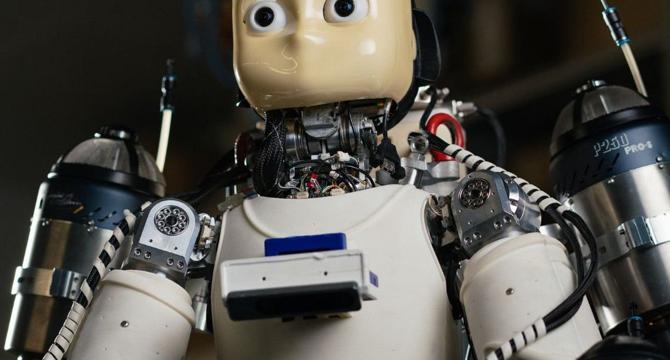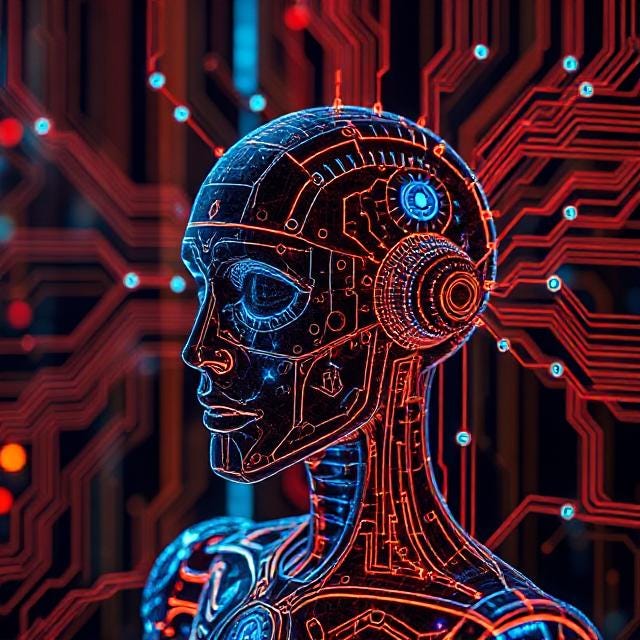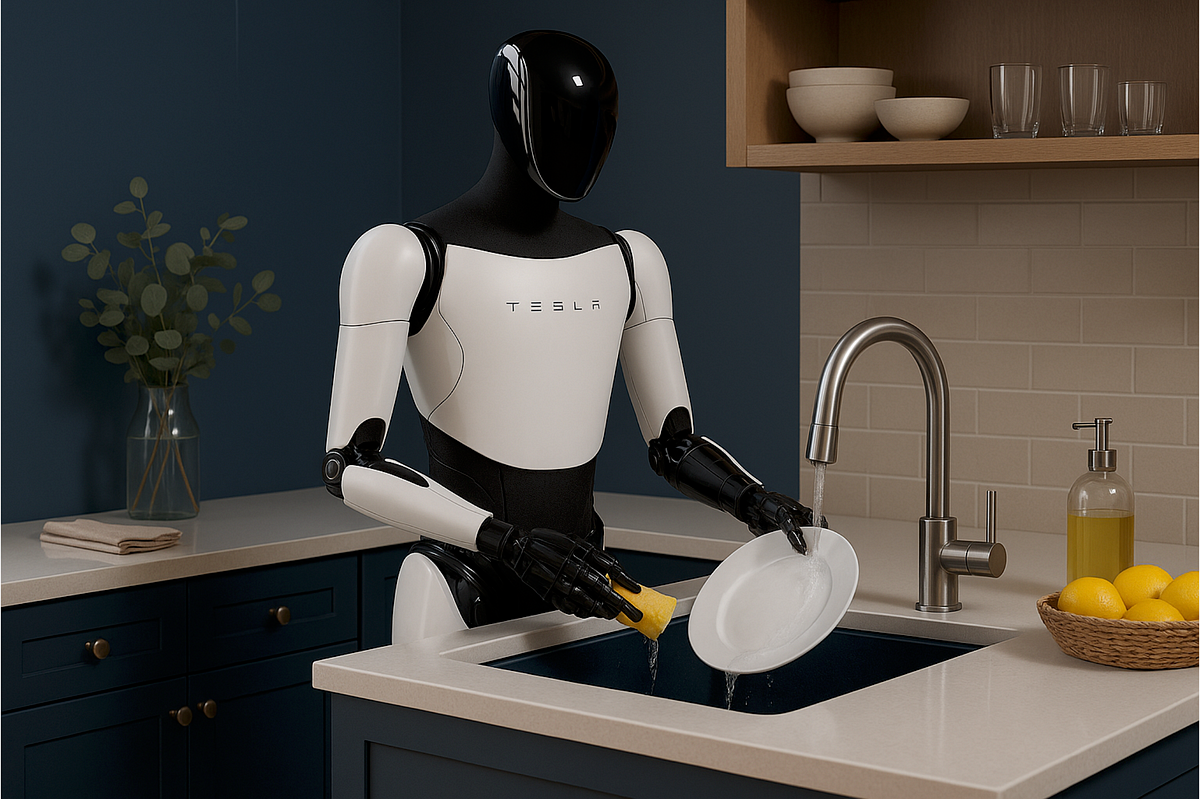Robotics News
Siliconangle
328

Image Credit: Siliconangle
The AI infrastructure boom: From sovereign compute to global creativity
- A tidal wave of AI-driven innovation is reshaping global technology with a focus on next-gen infrastructure.
- Key points include the importance of regional AI infrastructure, the rise of sovereign AI strategies, and the impact on global technology development.
- Discussions with industry leaders highlight the stages of enterprise AI product development and the push for AI sovereignty.
- The need for cultural relevance, language preservation, and human-centric innovation in AI infrastructure is emphasized.
- Emphasis on distributed innovation, evolving cloud models, and supporting local talent and governance within AI ecosystems.
- The evolving software stack to support AI workflows and the role of AI as a productivity engine and entrepreneurship catalyst are discussed.
- The article provides insights into the current state and future outlook of AI infrastructure and its impact on global economies.
- The content covers a range of topics from geopolitics to technology development and the importance of AI sovereignty.
- Overall, the article offers a comprehensive look at the AI infrastructure boom and its implications for various sectors.
- The discussions highlight the shift towards sovereign AI and the efforts to localize AI technologies for global impact.
Read Full Article
19 Likes
The Robot Report
96

IDS Imaging adds Sony Starvis 2 sensors to GigE uEye LE series
- IDS Imaging Development Systems GmbH is enhancing its GigE uEye LE series project cameras by incorporating Sony Starvis 2 sensors at the end of June 2025.
- The Sony Starvis 2 sensors are aimed at supporting image processing applications in areas like quality assurance, medical technology, and automation, maintaining consistent performance in low-light environments.
- The new single-board cameras are GigE Vision-compliant, compact, and suitable for high-volume applications, catering to cost-sensitive industrial projects.
- IDS Imaging will offer models with sensor options including the IMX675 (5 MP), IMX676 (12.5 MP), and IMX678 (8 MP) to meet diverse application requirements.
- The 12.5 MP model with a square 1/1.6″ sensor is ideal for applications such as microscopy.
- The Sony Starvis 2 sensors utilize CMOS technology to enhance light sensitivity, reduce noise, and broaden the dynamic range, enabling detailed image capture in varying lighting conditions.
- The introduction of the new models expands IDS's portfolio of image processing components, emphasizing flexibility and cost efficiency.
- The GigE uEye LE series cameras follow a design-to-cost strategy, catering to users seeking to integrate camera technology into machines, devices, or embedded systems.
Read Full Article
5 Likes
The Robot Report
224

Applied Intuition raises $600M for autonomous driving tech
- Applied Intuition raised $600 million in a Series F funding round, valuing the company at $15 billion, to fuel growth in vehicle intelligence, product expansion, and team growth.
- The funding will support the development, deployment, and updating of autonomous vehicle software, hardware, and AI applications through Applied Intuition's Vehicle OS.
- Co-founder and CEO Qasar Younis emphasized scaling investments in bringing intelligence into various machines, including cars, trucks, drones, and factories, connecting AI with the physical world.
- BlackRock and Kleiner Perkins co-led the funding round, with participation from new investors like Franklin Templeton, Qatar Investment Authority, and existing investors including Fidelity and General Catalyst.
- Applied Intuition plans to accelerate the rollout of intelligent, software-defined systems across multiple sectors like defense, automotive, trucking, construction, mining, and agriculture.
- The company has achieved significant milestones such as AI innovations, product launches, partnerships with industry leaders, acquisition of EpiSci, and expansion into the United Kingdom.
- Kleiner Perkins expressed confidence in Applied Intuition's vision and team, recognizing the company as a generational player in the fields of vehicle intelligence and autonomy.
- Founded in 2017, Applied Intuition provides Vehicle OS and autonomy stacks to help customers in different industries develop intelligent vehicles, with global offices across various locations.
- The company continues to focus on AI innovations and strategic partnerships, reaffirming its commitment to advancing vehicle intelligence and autonomy.
- Applied Intuition's recent achievements include releasing its off-road autonomy stack, acquiring EpiSci, and introducing defense products Axion and Acuity.
- The funding round follows Applied Intuition's Series E from March 2024 and marks the company's progress in enabling intelligent systems at scale.
- The company emphasizes the importance of AI in transforming machines, aiming to power various moving machines with AI technology.
- Investors like BlackRock and Kleiner Perkins are supporting Applied Intuition's mission of advancing intelligent, software-defined systems across different domains.
- Applied Intuition's mission is to connect AI with physical entities to revolutionize various industries with intelligent, software-defined solutions.
- Applied Intuition's toolchain and autonomy solutions cater to industries like automotive, defense, trucking, construction, mining, and agriculture, shortening the time to market for intelligent vehicles.
- The company's growth plans include deeper product expansion, increased investments in vehicle intelligence, and expanding its global team in the autonomous driving tech sector.
Read Full Article
13 Likes
IEEE Spectrum
352

Image Credit: IEEE Spectrum
Video Friday: Jet-Powered Humanoid Robot Lifts Off
- Video Friday is a weekly selection of robotics videos by IEEE Spectrum.
- The videos include demonstrations like a jet-powered humanoid robot lifting off.
- Robotic events and advancements are mentioned throughout the selection.
- Some robots showcased are designed for specific tasks like ship inspection and generalist AI applications.
- SLAPBOT, a robot with a provocative design, simulates slapping without making physical contact.
- There are references to radar-based safety systems for robots.
- Various institutions and companies contributing to robotics are acknowledged.
- The selection also includes a plenary talk on robotics models by Raffaello D’Andrea.
- The theme of data's role in robotics and automation is discussed as well.
Read Full Article
21 Likes
Discover more
TechCrunch
295

Image Credit: TechCrunch
SoftBank reportedly looking to launch a trillion-dollar AI and robotics industrial complex
- SoftBank, known for its involvement in the Stargate AI Infrastructure project, is reportedly planning a trillion-dollar AI and robotics industrial complex.
- The conglomerate is looking to collaborate with Taiwan Semiconductor Manufacturing Company (TSMC) on the project in Arizona, called Project Crystal Land.
- Details about TSMC's exact role and involvement in the initiative are not clear at this early stage.
- SoftBank has been associated with a $19 billion investment in the Stargate project.
- TSMC, however, is already working on its own AI infrastructure projects in Arizona.
- The initiative seems to be in its early development phase, with more information about the partnership awaited.
- Bloomberg reported on the potential collaboration between SoftBank and TSMC for Project Crystal Land.
- TechCrunch has reached out to SoftBank for further details.
- SoftBank's new project indicates a significant push into the AI and robotics sector.
- The industrial complex in Arizona could reshape the landscape of AI manufacturing.
- The extent of TSMC's participation in the project remains uncertain.
- SoftBank's ambition for Project Crystal Land aligns with its focus on cutting-edge technologies.
- The partnership with TSMC could enhance the scale and capabilities of the AI and robotics complex.
- SoftBank's move underscores the growing importance of AI in various industries.
- The development of AI infrastructure in Arizona by these companies highlights the region's significance in tech innovation.
- The future implications of SoftBank and TSMC's collaboration on Project Crystal Land are eagerly anticipated.
Read Full Article
17 Likes
Medium
941

Image Credit: Medium
From Deep Blue to Smart Devices: How Reactive AI Still Powers Today’s Tech.
- Reactive Artificial Intelligence (AI) is a basic AI system that operates in real time.
- It responds directly to inputs without memory storage or learning from past interactions.
- These systems are rule-based and behave predictably for their designed tasks.
- In 1997, IBM’s Deep Blue defeated world chess champion Garry Kasparov, showcasing reactive AI's power.
- Deep Blue based its moves on brute-force processing, evaluating millions of moves in real time.
- This event marked the global introduction of reactive AI for problem-solving.
- Despite advancements in AI, reactive AI principles are still prevalent in modern tech.
- Smart devices like thermostats, automatic lights, robotic vacuums, and customer service bots utilize reactive AI for quick decisions.
Read Full Article
26 Likes
Pymnts
106

Image Credit: Pymnts
SoftBank Seeks Support for Proposed $1 Trillion Complex to Build Robots and AI
- SoftBank is seeking support to build a $1 trillion manufacturing complex in Arizona focusing on robots and AI.
- Founder Masayoshi Son has discussed partnerships with TSMC and Samsung, seeking tax incentives from the U.S. government.
- The project is in early stages, with no guarantee of moving forward yet.
- SoftBank planned a $1 trillion investment to build AI-equipped factories in the U.S. in industrial parks.
- Son announced a $100 billion investment in the U.S., creating 100,000 jobs focused on AI and related infrastructure.
- SoftBank is also part of the Stargate project, a $500 billion initiative with other tech partners.
- The project aims to build data centers and AI infrastructure in the U.S. due to increasing AI demands.
- SoftBank planned nearly $9 billion investment in AI, doubling investments and commitments.
- The company maintains a safe balance sheet for flexibility in moving forward with its plans.
Read Full Article
1 Like
The Robot Report
388

Reservoir Farms opens applications for inaugural cohort
- Reservoir Farms, an agricultural technology incubator in the Salinas Valley, has opened applications for its inaugural cohort of 12 startups.
- The initiative is aimed at fostering innovation in specialty crop production by connecting AgTech startups with growers and access to expertise and networks of Western Growers Association.
- Reservoir Farms offers workspace for agrobotics startups to develop and test ideas rapidly, including access to secure storage sheds and a fully equipped maker space.
- Selected startups will focus on advancing technologies like robotic harvesting, machine vision, edge AI, and precision soil analytics to enhance efficiency and sustainability in specialty crop farming.
- The incubator was established to address the need for technological advancements in agriculture and ensure input from growers in developing new systems.
- Startups collaborating with industry professionals through Reservoir Farms can tailor their technologies to meet the unique demands of the agricultural sector.
- Applications are now open for the first cohort, offering startups the opportunity to work closely with Western Growers and industry leaders to refine and test their AgTech innovations.
- Reservoir Farms' location at Highway 68 and Hitchcock Road in Salinas is surrounded by productive farmland and supported by the Tanimura family and Tanimura & Antle.
- The initiative is fully backed by the Western Growers Association, aiming to accelerate the adoption of cutting-edge solutions in agriculture.
- Reservoir Farms includes year-round test fields for in-field testing of robotics and technologies for specialty crop farming.
- Technologies developed within the incubator are expected to enhance productivity and bring transformative advancements to the industry.
- The collaborative approach of Reservoir Farms ensures that new AgTech systems are practical and suited to real-world farming environments.
- The mentorship model of the incubator provides startups with insights into growers' challenges, fostering the creation of viable AgTech innovations.
- The Reservoir's CEO, Danny Bernstein, expressed gratitude for the collaboration with the Tanimura and Antle families and the broader grower community on California's Central Coast.
- Applications for the inaugural cohort are now open, welcoming startups to refine their technologies and test products in real farm settings under the mentorship of industry professionals.
Read Full Article
23 Likes
Medium
428

Image Credit: Medium
Five Humanoid Robots That Are Already Changing the World (And One That’s Giving Us Chills)
- The global humanoid robotics market is growing rapidly with estimated potential revenues reaching $38 billion by 2035 and $24 trillion by 2050.
- Numerous startups are developing humanoid robots for various industries such as logistics, healthcare, education, and customer service.
- Companies like Figure AI, Dexterity, and Amazon are investing in humanoid robots for warehouse automation and order processing.
- In healthcare, robots like Moxi, Pepper, and E-BRAiN are assisting with patient care, intern training, and offering human-like comfort in clinical settings.
- Humanoid robots are being utilized in stores and hotels to interact with customers, provide recommendations, and serve as concierges.
- Robots are also making their way into schools to assist with experiments, language learning, and improving academic performance for students.
- At a conference, a humanoid robot named RIA from Machani Robotics participated in a panel discussion on AI ethics, highlighting the robots' potential in societal debates.
- While humanoid robots are advancing rapidly, there are challenges such as societal discomfort with their human-like features and capabilities.
- Despite fears of job displacement, humanoid robots are designed to enhance efficiency, reduce workload, and automate dangerous tasks rather than replace humans completely.
- The integration of humanoid robots into everyday life is accelerating, driven by significant investments, technological advancements, and business demands.
- The future of humanoid robots is promising, with potential applications expanding across various sectors, making them increasingly common in everyday scenarios.
Read Full Article
25 Likes
The Robot Report
326

All3 launches AI and robotics to tackle housing construction
- All3, a London-based company, unveiled its building system integrating AI and robotics to address housing construction challenges in Europe and North America.
- The construction industry spends less on R&D than other sectors, leading to manual labor reliance and skilled worker shortages.
- All3 aims to revolutionize construction with a vertically integrated AI and robotics approach, streamlining processes for faster, cost-effective, and sustainable development.
- The company's technology offers bespoke designs, automated manufacturing, and robotic assembly, particularly suited for inner-city sites and complex projects.
- All3's AI platform facilitates custom building designs and optimized space utilization, enhancing productivity and sustainability in housing construction.
- By using structural timber composites and standard building elements, All3 automates design generation, manufacturing, and robot programming, reducing costs and enhancing efficiency.
- Targeting real estate developers, All3 promises to accelerate project timelines, reduce costs, and minimize carbon impact by integrating AI and robotics across the construction value chain.
- Founded by experienced entrepreneurs, All3 has secured $30 million in funding and plans to commence construction on its first build in Europe in 2025.
- With a focus on delivering end-to-end solutions for multifamily housing, All3 envisions a future where robotic automation dominates construction processes.
- The company's innovative approach to housing construction signifies a significant shift towards AI and robotics-driven solutions in the industry.
Read Full Article
19 Likes
The Robot Report
274

Simbe, Coresight Research study finds retailers urgently need to reduce inefficiencies
- Simbe Robotics Inc. and Coresight Research released the 'State of In-Store Retailing 2025' report emphasizing the need for retailers to digitize stores using AI and automation.
- Retailers are losing $162.7 billion annually due to in-store inefficiencies, with pressure mounting and facing increased margin pressure.
- The report highlights challenges like losing 5.5% of gross sales to inefficiencies, driven by labor challenges, shrinkage, manual tasks, and employee turnover.
- Execution gaps are widening, with promotion execution errors, pricing errors, and misplaced items being top operational challenges.
- Despite adopting store intelligence technologies, only 20% of retailers have fully scaled them, leaving room for early movers to lead.
- Investment in store intelligence technologies is up by 151% year-over-year, particularly in shelf-digitization technologies like robotics, showing increased adoption.
- Retailers failing to adopt holistic store intelligence strategies risk falling behind as automation reshapes in-store execution, per Coresight Research's CEO.
- Simbe's Store Intelligence platform has benefited retailers, with examples like ShopRite reducing out-of-stocks by 50% using the autonomous Tally robot.
- Partnership with DeCicco & Sons, a NY grocery chain, integrates Simbe's platform to enhance product availability, pricing accuracy, and service quality.
- Simbe's expansion on the East Coast is furthered by the partnership with DeCicco, highlighting the company's role in modern retail infrastructure.
Read Full Article
16 Likes
The Robot Report
101

Celebrating 200 podcast episodes; robotics evolve in space exploration
- Dr. Robert Ambrose, the chairman of robotics and artificial intelligence at Alliant, discusses the evolution of robotics in space exploration in Episode 200 of The Robot Report Podcast.
- Ambrose highlights the transition to commercial applications, importance of education in engineering, and the need for the U.S. to lead in robotics amidst global competition.
- Selected NASA projects led by Dr. Ambrose include Robonaut, Valkyrie, Centaur, Chariot rovers, LTV rover, MRV, Resource Prospector, wearable robotics, ISS support systems, and software and simulation.
- Ambrose's career at NASA focused on developing innovative robotic platforms and technologies for human and robotic space exploration.
- Historical facts about The Robot Report Podcast, including key episodes, milestones, and guest appearances, are highlighted.
- Notable milestones include the 200th episode, testimonials from prior guests, and significant episodes featuring various industry experts.
- The podcast has uploaded over 13,500 minutes, averages 1,670 plays per episode, and has accumulated more than 334,000 plays.
- Mike Oitzman joined as co-host and producer on Episode 39, and key episodes like 100 and 132 are mentioned along with the most listened-to episode, Episode 166.
- The show's timeline is summarized, featuring testimonials, a historical recap, and an interview with Dr. Ambrose.
Read Full Article
6 Likes
The Robot Report
420

PrismaX launches with $11M to scale virtual datasets for robotics foundation models
- PrismaX launches with $11M funding to address challenges in physical AI and robotics industry.
- The platform aims to provide reliable data for training artificial intelligence models for robots.
- PrismaX is building a robotics teleoperations platform to create an ecosystem for diverse and scalable datasets.
- The company is developing a standard for fair data use and revenue sharing in the industry.
- The founders emphasize the importance of human capital in building models for autonomous robots.
- PrismaX focuses on data, teleoperation, and models as foundational elements for robotics advancements.
- The company plans to create a 'data flywheel' by improving data quality, teleoperation efficiency, and real-world data collection.
- PrismaX plans to build humanoid robots capable of various tasks and aims to expand its fleet.
- a16z CSX led the $11M funding round for PrismaX, with several other investors participating.
- The funding will be used to enhance teleop standards, expand data-collection portal, and attract AI enthusiasts.
- PrismaX's launch coincided with a16z's CSX Demo Day on June 3.
- The company intends to empower robotics firms by providing access to teleoperators for scaling visual datasets.
- PrismaX seeks to accelerate the building of smarter machines through community participation.
- PrismaX envisions creating an ecosystem that promotes innovation and collaboration in the robotics industry.
- The company aims to drive breakthroughs in robotics by harnessing advanced technologies and decentralized approaches.
- PrismaX is set to revolutionize data collection, teleoperation standards, and model development in AI and robotics.
Read Full Article
25 Likes
Livescience
123

Image Credit: Livescience
China pits rival humanoids against each other in world's first 'robot boxing tournament'
- The world's first humanoid robot combat competition took place in China with four Chinese teams competing against each other.
- The competition featured Unitree's G1 humanoid robots engaging in combat with punches, kicks, and dodges.
- Teams utilized unique tactics, with the green team focusing on steady pressure, and the pink team leveraging muscle memory precision.
- The G1 robots have advanced movement capabilities with seven degrees of freedom in their arms.
- Humanoid robots require special algorithms and sensors to maintain balance during complex movements.
- Unitree used AI reinforcement training to teach the G1 robots optimal behaviors and keep them upright during combat.
- The robots underwent intensive training to withstand physical strain and remain stable in combat situations.
- Future tournaments will see Unitree deploying robots with more advanced motion-sensing control systems for improved combat immersion.
Read Full Article
7 Likes
Analyticsindiamag
55

Image Credit: Analyticsindiamag
LG CNS Signs Deal with Skild AI to Build Industrial Humanoid Robots
- South Korean LG CNS partners with US-based Skild AI to develop industrial humanoid robot solutions for complex physical tasks.
- The agreement includes a technology partnership and equity investment through LG Technology Ventures.
- AI-powered humanoid robots will target manufacturing, logistics, and urban services to enhance efficiency and reduce costs.
- Skild AI, founded in 2023, utilizes the robot foundation model (RFM) for autonomous decision-making.
- LG CNS plans to offer a holistic service package combining Skild AI's RFM and its robot control platform.
- The initiative aims to integrate humanoid robots into smart factory, logistics, and urban solutions.
- LG CNS enters the industrial humanoid robotics sector to enhance AI applications.
- NVIDIA and Samsung reportedly invest $35 million in Skild AI, with LG CNS contributing $10 million.
- Skild AI's Series B funding round values the company at around $4.5 billion, led by a $100 million investment from SoftBank Group.
- Skild AI recently accelerated the development of its humanoid robot brain, 'Skild Brain,' with AI solutions from Hewlett-Packard Enterprise.
Read Full Article
2 Likes
For uninterrupted reading, download the app